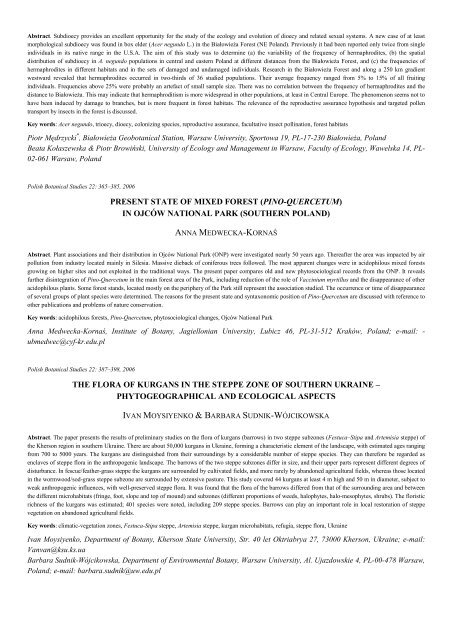Polish Botanical Studies 22 (2006)
Polish Botanical Studies 22 (2006)
Polish Botanical Studies 22 (2006)
Create successful ePaper yourself
Turn your PDF publications into a flip-book with our unique Google optimized e-Paper software.
Abstract. Subdioecy provides an excellent opportunity for the study of the ecology and evolution of dioecy and related sexual systems. A new case of at least<br />
morphological subdioecy was found in box elder (Acer negundo L.) in the BiałowieŜa Forest (NE Poland). Previously it had been reported only twice from single<br />
individuals in its native range in the U.S.A. The aim of this study was to determine (a) the variability of the frequency of hermaphrodites, (b) the spatial<br />
distribution of subdioecy in A. negundo populations in central and eastern Poland at different distances from the BiałowieŜa Forest, and (c) the frequencies of<br />
hermaphrodites in different habitats and in the sets of damaged and undamaged individuals. Research in the BiałowieŜa Forest and along a 250 km gradient<br />
westward revealed that hermaphrodites occurred in two-thirds of 36 studied populations. Their average frequency ranged from 5% to 15% of all fruiting<br />
individuals. Frequencies above 25% were probably an artefact of small sample size. There was no correlation between the frequency of hermaphrodites and the<br />
distance to BiałowieŜa. This may indicate that hermaphroditism is more widespread in other populations, at least in Central Europe. The phenomenon seems not to<br />
have been induced by damage to branches, but is more frequent in forest habitats. The relevance of the reproductive assurance hypothesis and targeted pollen<br />
transport by insects in the forest is discussed.<br />
Key words: Acer negundo, trioecy, dioecy, colonizing species, reproductive assurance, facultative insect pollination, forest habitats<br />
Piotr Mędrzycki * , BiałowieŜa Geobotanical Station, Warsaw University, Sportowa 19, PL-17-230 BiałowieŜa, Poland<br />
Beata Kołaszewska & Piotr Browiński, University of Ecology and Management in Warsaw, Faculty of Ecology, Wawelska 14, PL-<br />
02-061 Warsaw, Poland<br />
<strong>Polish</strong> <strong>Botanical</strong> <strong>Studies</strong> <strong>22</strong>: 365–385, <strong>2006</strong><br />
PRESENT STATE OF MIXED FOREST (PINO-QUERCETUM)<br />
IN OJCÓW NATIONAL PARK (SOUTHERN POLAND)<br />
ANNA MEDWECKA-KORNAŚ<br />
Abstract. Plant associations and their distribution in Ojców National Park (ONP) were investigated nearly 50 years ago. Thereafter the area was impacted by air<br />
pollution from industry located mainly in Silesia. Massive dieback of coniferous trees followed. The most apparent changes were in acidophilous mixed forests<br />
growing on higher sites and not exploited in the traditional ways. The present paper compares old and new phytosociological records from the ONP. It reveals<br />
further disintegration of Pino-Quercetum in the main forest area of the Park, including reduction of the role of Vaccinium myrtillus and the disappearance of other<br />
acidophilous plants. Some forest stands, located mostly on the periphery of the Park still represent the association studied. The occurrence or time of disappearance<br />
of several groups of plant species were determined. The reasons for the present state and syntaxonomic position of Pino-Quercetum are discussed with reference to<br />
other publications and problems of nature conservation.<br />
Key words: acidophilous forests, Pino-Quercetum, phytosociological changes, Ojców National Park<br />
Anna Medwecka-Kornaś, Institute of Botany, Jagiellonian University, Lubicz 46, PL-31-512 Kraków, Poland; e-mail: -<br />
ubmedwec@cyf-kr.edu.pl<br />
<strong>Polish</strong> <strong>Botanical</strong> <strong>Studies</strong> <strong>22</strong>: 387–398, <strong>2006</strong><br />
THE FLORA OF KURGANS IN THE STEPPE ZONE OF SOUTHERN UKRAINE –<br />
PHYTOGEOGRAPHICAL AND ECOLOGICAL ASPECTS<br />
IVAN MOYSIYENKO & BARBARA SUDNIK-WÓJCIKOWSKA<br />
Abstract. The paper presents the results of preliminary studies on the flora of kurgans (barrows) in two steppe subzones (Festuca–Stipa and Artemisia steppe) of<br />
the Kherson region in southern Ukraine. There are about 50,000 kurgans in Ukraine, forming a characteristic element of the landscape, with estimated ages ranging<br />
from 700 to 5000 years. The kurgans are distinguished from their surroundings by a considerable number of steppe species. They can therefore be regarded as<br />
enclaves of steppe flora in the anthropogenic landscape. The barrows of the two steppe subzones differ in size, and their upper parts represent different degrees of<br />
disturbance. In fescue/feather-grass steppe the kurgans are surrounded by cultivated fields, and more rarely by abandoned agricultural fields, whereas those located<br />
in the wormwood/sod-grass steppe subzone are surrounded by extensive pasture. This study covered 44 kurgans at least 4 m high and 50 m in diameter, subject to<br />
weak anthropogenic influences, with well-preserved steppe flora. It was found that the flora of the barrows differed from that of the surrounding area and between<br />
the different microhabitats (fringe, foot, slope and top of mound) and subzones (different proportions of weeds, halophytes, halo-mesophytes, shrubs). The floristic<br />
richness of the kurgans was estimated; 401 species were noted, including 209 steppe species. Barrows can play an important role in local restoration of steppe<br />
vegetation on abandoned agricultural fields.<br />
Key words: climatic-vegetation zones, Festuca-Stipa steppe, Artemisia steppe, kurgan microhabitats, refugia, steppe flora, Ukraine<br />
Ivan Moysiyenko, Department of Botany, Kherson State University, Str. 40 let Oktriabrya 27, 73000 Kherson, Ukraine; e-mail:<br />
Vanvan@ksu.ks.ua<br />
Barbara Sudnik-Wójcikowska, Department of Environmental Botany, Warsaw University, Al. Ujazdowskie 4, PL-00-478 Warsaw,<br />
Poland; e-mail: barbara.sudnik@uw.edu.pl
















